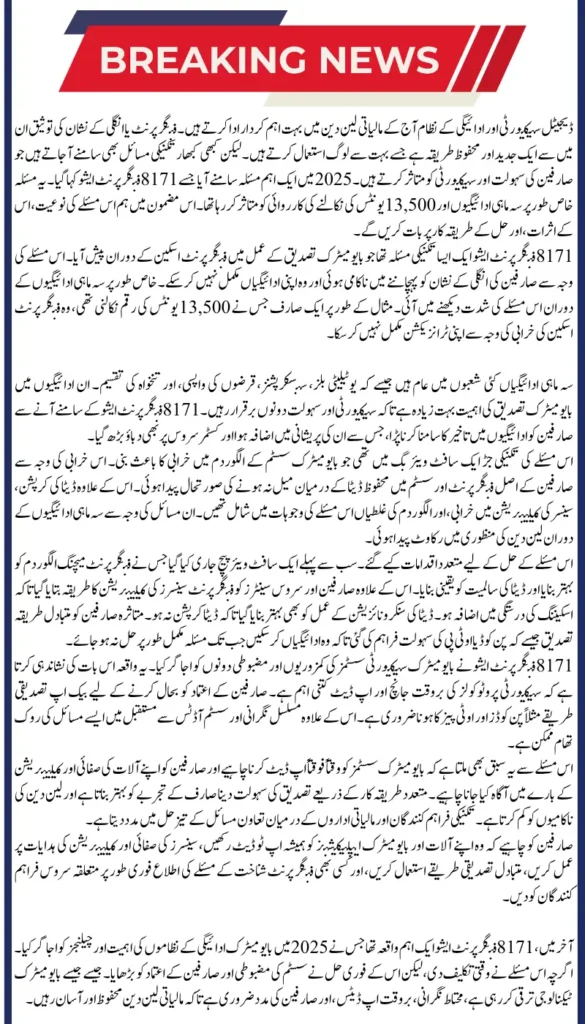8171 Fingerprint Issue Resolved for New Payment
8171 Fingerprint Issue Resolved for New Payment: Digital security plays a crucial role in modern financial transactions. Biometric authentication, especially fingerprint recognition, is a popular way to ensure safety and convenience. However, even advanced systems can face challenges. One significant problem that caught attention in 2025 was the 8171 fingerprint issue, which affected quarterly payments and a notable withdrawal of 13,500 units. This article explains what happened, how the problem was solved, and what users and institutions can learn from it.
What is the 8171 Fingerprint Issue?
The 8171 fingerprint issue refers to a specific technical glitch that caused fingerprint verification failures in biometric payment systems. Fingerprint authentication is widely used because it is fast and secure, but in this case, users experienced repeated errors when trying to authorize payments during their quarterly billing cycles.
A clear example was when a user attempted to withdraw 13,500 units as part of their quarterly payment. Due to the fingerprint scan errors, the withdrawal could not be processed. This disruption highlighted a critical weakness in biometric systems that many rely on daily.
Sindh’s New Polio Policy: Govt Weighs Blocking SIMs and IDs of Vaccine-Refusing Parents
How Did the 8171 Fingerprint Issue Affect Payments?
Quarterly payments are common for things like utility bills, subscriptions, loan repayments, and salary payments. These transactions depend on smooth biometric verification for security and ease of use. When the 8171 issue arose, many users faced delays and failures in completing these important payments.
For instance, users who needed to withdraw 13,500 units during the quarterly cycle were unable to verify their fingerprints, causing frustration and confusion. This also led to increased calls to customer support centers, putting extra pressure on service teams.

Technical Causes Behind the 8171 Fingerprint Issue
After investigation, the root cause of the problem was found in a software bug within the fingerprint verification system. The bug caused mismatches between the fingerprint data stored on servers and the scans taken by users’ devices. Several factors contributed to the problem:
- Data Corruption: Stored fingerprint templates sometimes became corrupted during syncing between devices and central servers.
- Sensor Calibration Errors: Some devices had poorly calibrated fingerprint sensors, leading to inaccurate scans.
- Algorithm Glitches: The matching algorithm occasionally failed to recognize valid fingerprints, resulting in false negatives.
Together, these issues caused many users to experience failed transaction verifications during peak times, especially during quarterly payments.
Punjab Matric Supply Exams 2025: Official Schedule Released for 10th Class Second Annual Papers
How Was the 8171 Fingerprint Issue Resolved?
Resolving the 8171 fingerprint issue required teamwork between biometric technology providers, payment platform developers, and security experts. The key steps taken included:
- Software Patch Deployment: Developers released updates to fix the fingerprint matching algorithm and improve data integrity.
- Sensor Recalibration Protocols: Instructions were given to users and service centers on how to recalibrate fingerprint sensors for better accuracy.
- Improved Data Synchronization: New methods were introduced to prevent data corruption during syncing.
- User Communication and Support: Affected users were informed about the problem and given alternative ways to authenticate, such as PIN codes or OTPs, while the fix was being applied.
Thanks to these measures, the issue was fully resolved within the first quarter of 2025, restoring trust and smooth functionality.
What Does the 8171 Fingerprint Issue Teach Us About Financial Security?
The 8171 fingerprint issue was a reminder of both the strengths and weaknesses of biometric payment systems. While the problem caused temporary disruptions, the rapid identification and resolution showed the maturity of current security and development practices.
- Building Trust in Biometric Payments: Users and institutions gained confidence knowing that fingerprint authentication can be reliable when maintained properly.
- Backup Authentication is Essential: The incident underscored the need for alternative methods like PINs or one-time passwords in case biometrics fail.
- Continuous Monitoring is Crucial: Regular system checks and audits help detect and prevent such bugs before they cause widespread issues.
Check BISP 13,500 October 2025 Payment Status Online via CNIC – 8171 Tracking Portal
Important Lessons Learned from the 8171 Fingerprint Issue
Several key takeaways emerged from this experience, which can help improve biometric payment systems in the future:
- Regular Software Updates: Keeping systems updated with patches is vital to security and smooth operation.
- User Education: Informing users about sensor maintenance and recalibration can reduce errors.
- Multiple Authentication Options: Providing users with backup methods improves convenience and reduces transaction failures.
- Collaborative Problem Solving: Strong communication between technology providers and financial institutions speeds up resolution times.
What Should Users Do Moving Forward?
To avoid problems like the 8171 fingerprint issue, users are advised to:
- Keep their device software and biometric applications updated.
- Follow the recommended steps for cleaning and calibrating fingerprint sensors.
- Use backup authentication methods offered by their payment platforms.
- Report any fingerprint recognition problems to customer support promptly.

